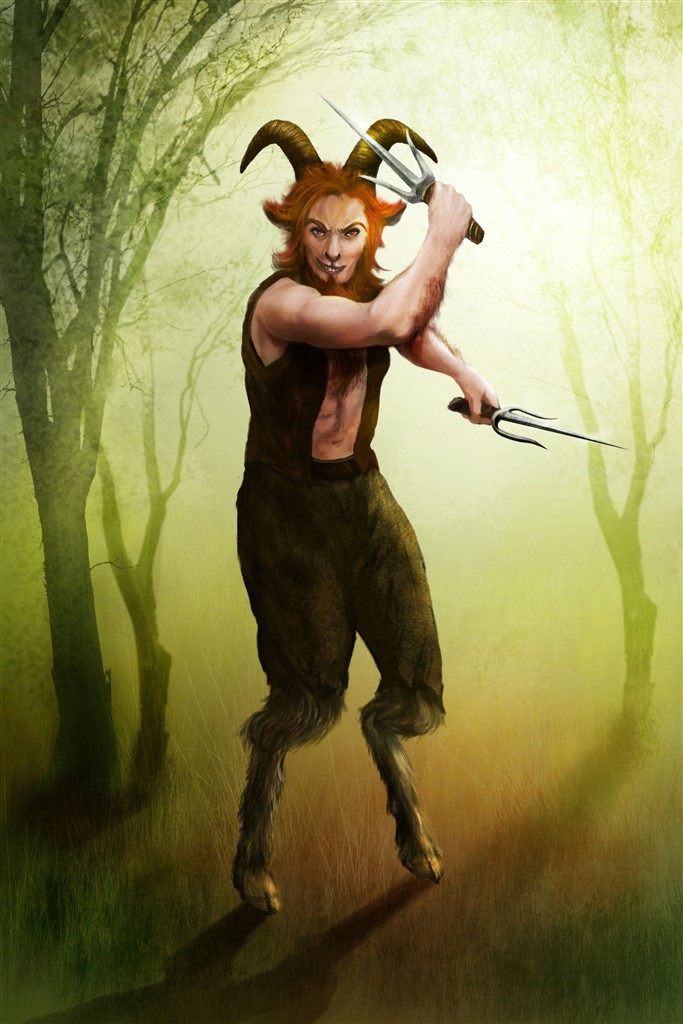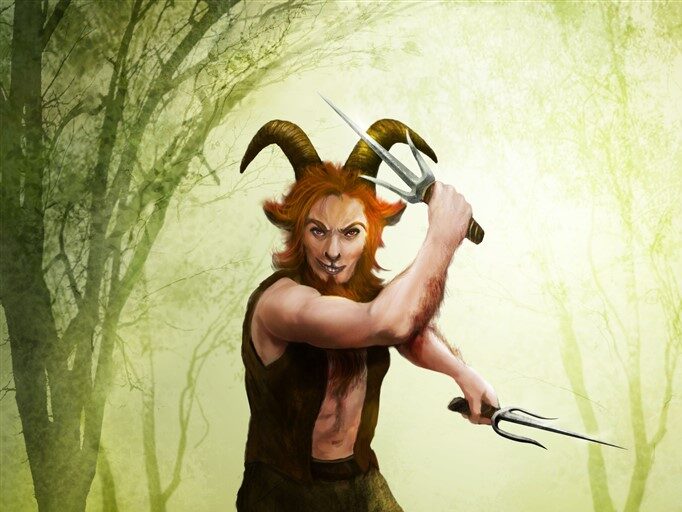Origin and Creation:
Satyrs in Nathakra are creatures of wild joy and cunning, originally birthed from the energies of the natural world. They were created as protectors of the wilds and guardians of the untamed aspects of nature, embodying freedom and the pursuit of pleasure. However, their history is marked by tragedy, particularly during the First Great War when they faced near extinction at the hands of the Minotaurs for refusing to align with the Lord of the Underworld.
Physical Appearance:
Satyrs are smaller, humanoid in appearance, with distinct features that set them apart:
- Height: Typically 5’0″ to 6’0″
- Weight: 100-150 pounds
- Body Structure: They have the torso of a human but with legs resembling those of a goat, complete with hooves. Their bodies are lean and agile, built for speed and stealth.
- Facial Features: Satyrs have slightly pointed ears, sharp eyes, and often sport a mischievous smile. Their hair is usually wild and curly, often matching the color of their fur, which ranges from dark brown to golden.
- Horns: Small, curved horns adorn their heads, varying in size and shape depending on their age and status.
- Fur: Their legs and lower body are covered in a thick coat of fur that matches the color of their hair.
- Mixed-racial breeding has led to a range of appearances within the Satyr community: some have more human-like faces while others retain a more distinctly goat-like visage. Some have longer tails, while other are tail-less. Despite these differences, there is no ill will towards those with “lesser” pure blood appearances in their society.
Social Structure and Hierarchy:
Satyr society is loosely organized, valuing freedom and individuality over rigid hierarchy. However, they do respect skill and cunning, especially in their chosen fields:
- Chief Trickster: The highest honor among Satyrs is given to those who have proven themselves in stealth, thievery, and trickery. Pan, the most famous of all Satyrs, holds this title and is revered as the embodiment of their ideals.
- Nimble Hooves: These Satyrs are renowned for their speed and agility, often serving as scouts or messengers. They are the second most respected group, often leading smaller bands of Satyrs.
- Wild Guardians: A lesser-known group within Satyr society, these individuals focus on protecting the natural world and maintaining balance. They are more connected to nature and less involved in the typical Satyr pursuits of pleasure and mischief.
- Common Satyrs: The majority of Satyrs, who engage in various activities, from thievery and trickery to simple trades. They live for the thrill of the moment and the pursuit of pleasure.
Behavior and Culture:
- Thievery and Stealth: Satyrs are natural thieves, their nimble fingers and quick reflexes making them adept at stealing from unsuspecting targets. They thrive on the challenge of taking what they desire without getting caught, and their culture celebrates cunning and resourcefulness.
- Rivalry with Minotaurs: Their mortal enemies are the Minotaurs, who nearly drove them to extinction during the First Great War. The Satyrs’ refusal to side with the Lord of the Underworld and their opposition to tyranny has earned them the respect of those who stand for the light, though they themselves often operate outside the law.
- Love of Pleasure: Satyrs are known for their unrestrained hedonism. They pursue pleasure in all its forms, from fine wines and music to the chase of women. Their libido is legendary, and they are often distracted from their duties by the allure of a potential romantic conquest.
- Desert Dwellers: Most Satyrs reside in or near the desert city of Satryos, where the dry, warm climate suits them best. They avoid wet weather, finding it uncomfortable and stifling.
- Music and Dance: Music is a central part of Satyr life, with many being talented musicians. Their pipes, flutes, and drums are heard in the wilds, often leading to impromptu dances and revelries that can last for days.
Traits and Abilities:
- Enhanced Agility: Satyrs are incredibly nimble, able to move with speed and precision. This agility makes them difficult to catch and deadly in combat, especially in hit-and-run tactics.
- Invisibility to the Unaware: When fully focused, Satyrs can become nearly invisible to those not actively searching for them, blending seamlessly with their surroundings.
- Charisma: Their charm is almost magical, allowing them to talk their way out of difficult situations or seduce potential lovers with ease.
- Pan’s Gift: Some Satyrs possess the ability to play a magical tune on their pipes that can enchant or befuddle those who hear it, making them susceptible to suggestion or causing them to fall into a deep sleep.
Psychological Traits:
- Mischievous Nature: Satyrs are inherently playful and mischievous, often playing pranks on those they encounter. This behavior can sometimes lead them into trouble, but their quick wits usually help them escape unscathed.
- Unyielding Optimism: Despite their tragic history, Satyrs are incredibly resilient. They live in the moment, refusing to dwell on past sorrows or future worries, which can make them seem carefree to the point of recklessness.
- Loyalty to Their Kind: While they may be untrustworthy to outsiders, Satyrs are fiercely loyal to their own. They will go to great lengths to protect their kin, especially against the threat of Minotaurs.
Habitat:
- Satryos: The desert city of Satryos is the heart of Satyr society, a place of hidden oases, lush gardens, and underground caverns. The city is a labyrinth of narrow streets and hidden passages, perfect for a race that thrives on stealth and misdirection.
- Wilderness: Some Satyrs prefer the untamed wilds, living in forests or on the edges of civilization where they can indulge their natural instincts and avoid the constraints of more structured societies.
Language:
- Sylvan: The native tongue of the Satyrs, a melodic and flowing language that reflects their connection to nature and their love of music.
- Common: They are also fluent in Common, using it to interact with other races and to further their various schemes and activities.
- Elvish: Many Satyrs have learned Elvish, particularly those who live near Elven communities or who engage in trade with them

Discover more from The World of Nathakra
Subscribe to get the latest posts sent to your email.

